In this article, we will explore the enchanting world of the Chocolate Goldendoodle , a captivating dog breed. With their beautiful chocolate coats, lovely curls, and delightful personality, these dogs have captured the hearts of many.
Join us as we delve into their unique charm, intelligence, and hypoallergenic qualities. Discover why the Chocolate Goldendoodle is the perfect companion for those seeking a beautiful, intelligent, and loving four-legged friend.
A Brief Overview of Chocolate Goldendoodle
| Characteristic | Description |
| Size | Varies based on size (Teacup, Toy, Mini, Medium, or Standard) |
| Temperament | Easygoing, calm, friendly |
| Exercise Requirements | 30 to 60 minutes per day |
| Lifespan | 12 to 16 years |
| Coat | Wavy or curly single chocolate coat |
| Shedding | Low |
What is a Chocolate Goldendoodle?

Chocolate Goldendoodles have a solid brown coat, ranging from light to dark shades. They may have small white patches, but technically, those are Brown and White Goldendoodles.
Initially, brown coats emerged due to a mutation in the gene responsible for producing black coats. This gene is recessive, meaning both parents must carry it to make a Chocolate Goldendoodle. Consequently, they are commonly found in back-cross generations such as F1b, F1bb, or F2b Goldendoodles.
Goldendoodle Generations Explained
They can be classified into various generations based on the lineage of their Poodle and Golden Retriever parents.
Let’s explore a few familiar generations of Chocolate Goldendoodles:
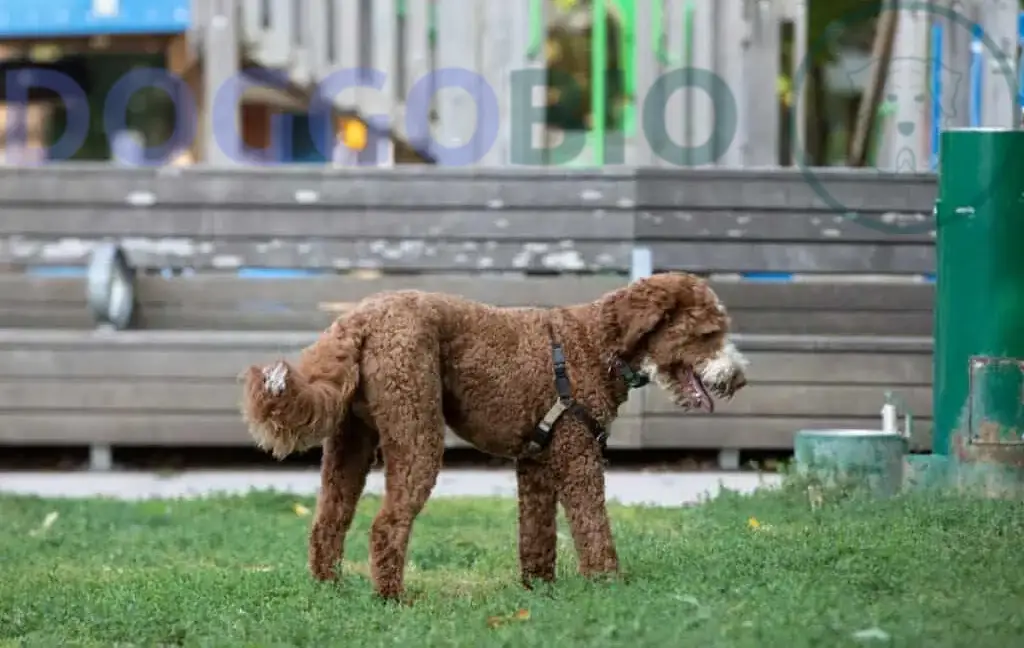
1.f1 chocolate goldendoodle
F1 Goldendoodles, short for first-generation Goldendoodles, are the initial offspring resulting from the crossbreeding of a purebred Poodle and a purebred Golden Retriever.
These delightful F1 Goldendoodles inherit 50% of their genetic makeup from each parent breed, resulting in a diverse range of coat types and colors, including the desirable chocolate hue.
2.f1b chocolate goldendoodle
F1b Goldendoodles, also known as second-generation Goldendoodles, are the offspring of an F1 Goldendoodle and a purebred Poodle. In this generation, the mix is 75% Poodle and 25% Golden Retriever. The breeding process increases the likelihood of a non-shedding coat, making F1b Goldendoodles a popular choice for individuals with allergies.
With their increased Poodle genetics, these delightful dogs offer the desired traits of a Goldendoodle while minimizing the risk of shedding.
3.Multigen chocolate Goldendoodle
Multigen Goldendoodles result from breeding two Goldendoodles or a Goldendoodle with a Poodle. These generations are known for their consistent traits and reduced shedding, making them an excellent option for families with allergies.
Why Do Goldendoodles Change Color?
The color change in Chocolate Goldendoodles is a natural process influenced by genetics, sun exposure, and the environment.
Genes can activate or deactivate, sun exposure can lighten or darken the coat, and environmental factors can impact color over time.
What Does a Chocolate Goldendoodle Look Like?
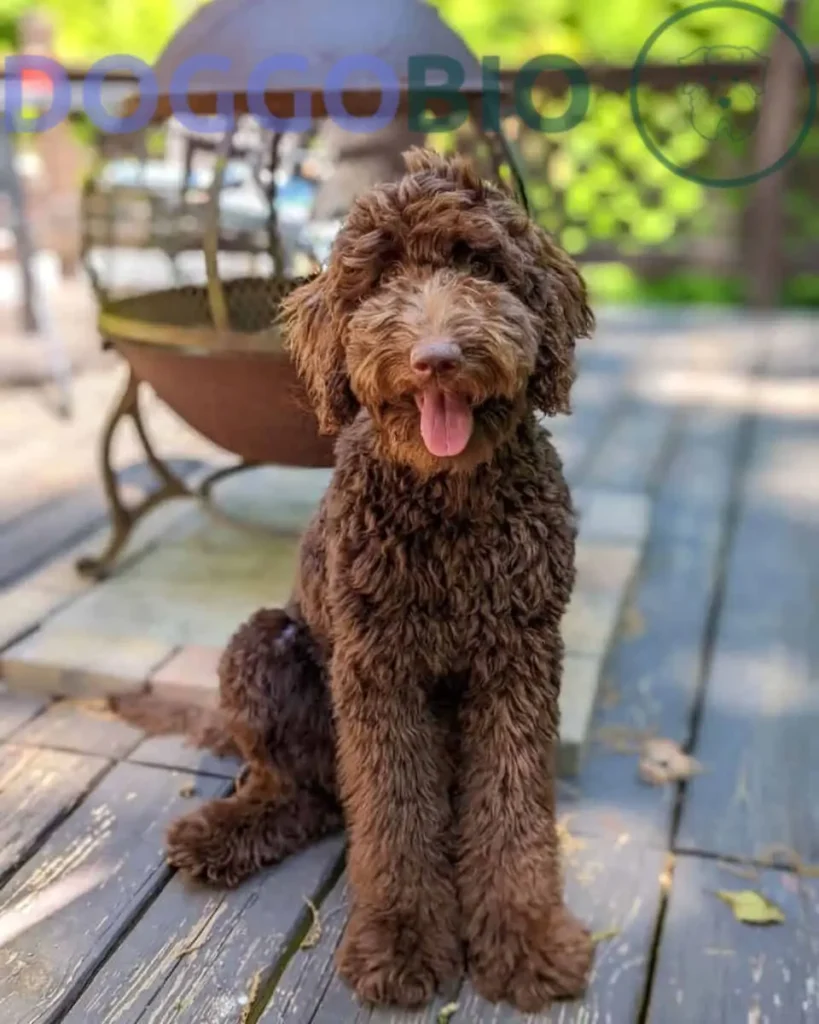
Size, height, and Weight
Chocolate Goldendoodles come in various sizes, influenced by their parent breeds and breeding practices. Typically, they stand between 20-24 inches in height and weigh around 50-90 pounds, with variations based on gender and individual size.
Chocolate Goldendoodles come in five sizes:
- Teacup (8-13 inches, 7-10 pounds),
- Toy (10-16 inches, 10-25 pounds),
- Mini (15-17 inches, 15-35 pounds),
- Medium (17-20 inches, 35-50 pounds),
- and Standard (20-26 inches, 50-90 pounds).
Each size offers a range of options to suit different preferences.
However, it’s crucial to remember that size alone doesn’t dictate their exercise requirements. All Chocolate Goldendoodles, regardless of size, benefit from regular exercise and social interaction to ensure their overall health and happiness.
Coat Colors and Types
Chocolate Goldendoodles come in various color variations, adding to their charm. The coat colors are influenced by their parent breeds, the Poodle and the Golden Retriever. Common color variations include:
- Chocolate and White,
- Chocolate and CreamCream,
- Chocolate and Tan,
- and Chocolate and Apricots.
It’s essential to remember that coat colors can differ among puppies, even within the same litter.
Inherit various coat types. Some may showcase straight, others wavy, and some flaunting irresistibly curly coats, while the textures may range from luxuriously dense to silky soft. A few will flaunt a single skin, while others may boast a cozy double layer, creating a mesmerizing tapestry of furry perfection.
1. Straight Coat
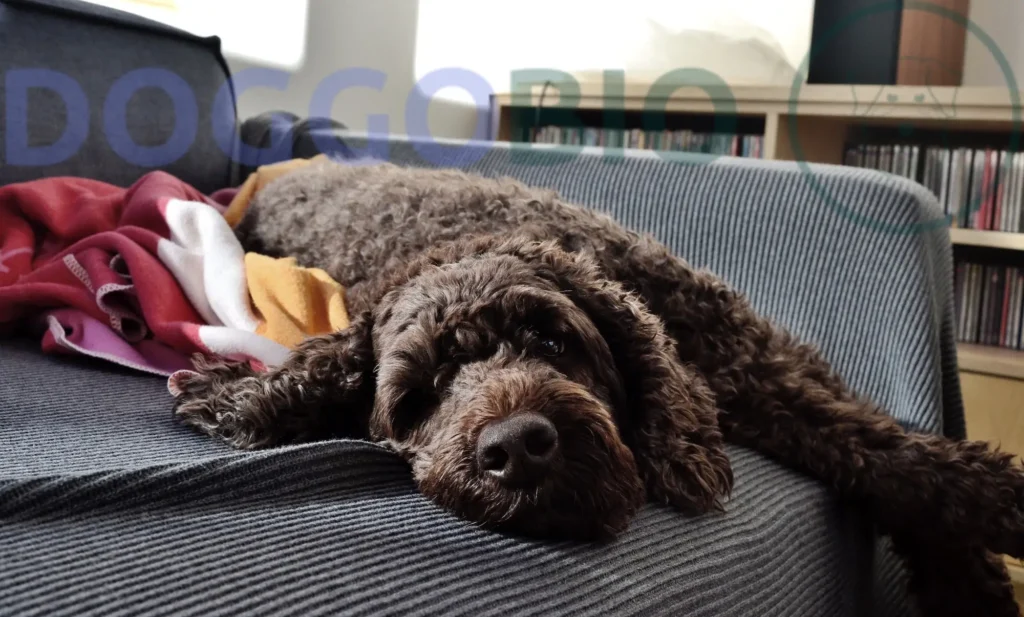
The Straight Chocolate Coat is a low-maintenance option for those who prefer simplicity. It’s usually straight or slightly wavy with a soft texture. Being shorter, it’s less prone to matting and tangling.
While Straight Goldendoodles do shed, they only require minimal grooming: brushing once or twice a week and occasional trimming to maintain their coat.
2. Curly Coat
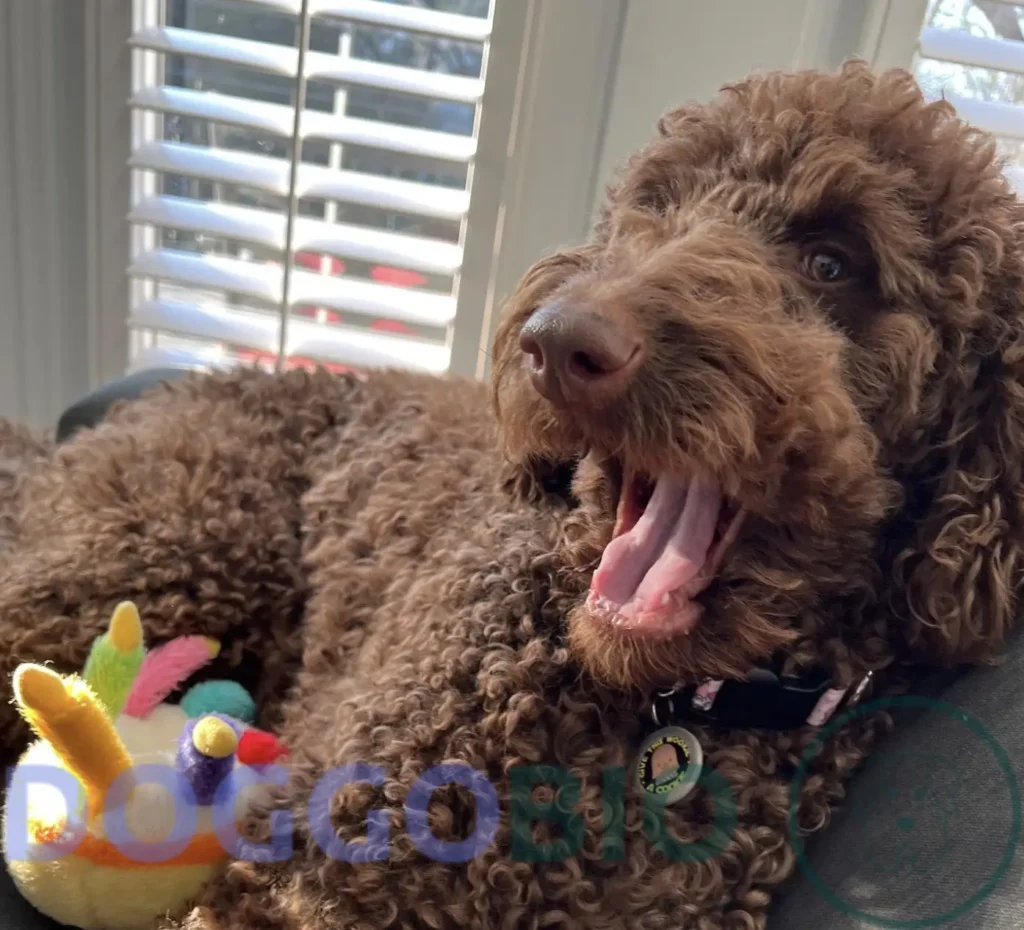
The Curly Chocolate Coat is a distinctive feature of Goldendoodles. It’s tight, springy, and has a soft, plush texture. Curly Chocolate Goldendoodles are often low-shedding and hypoallergenic, making them ideal for allergy sufferers.
However, their tight curls require regular maintenance, including frequent brushing and clipping, to prevent matting. Professional grooming every 6-8 weeks is advised for this coat type.
3. Shaggy or Wavy Coat
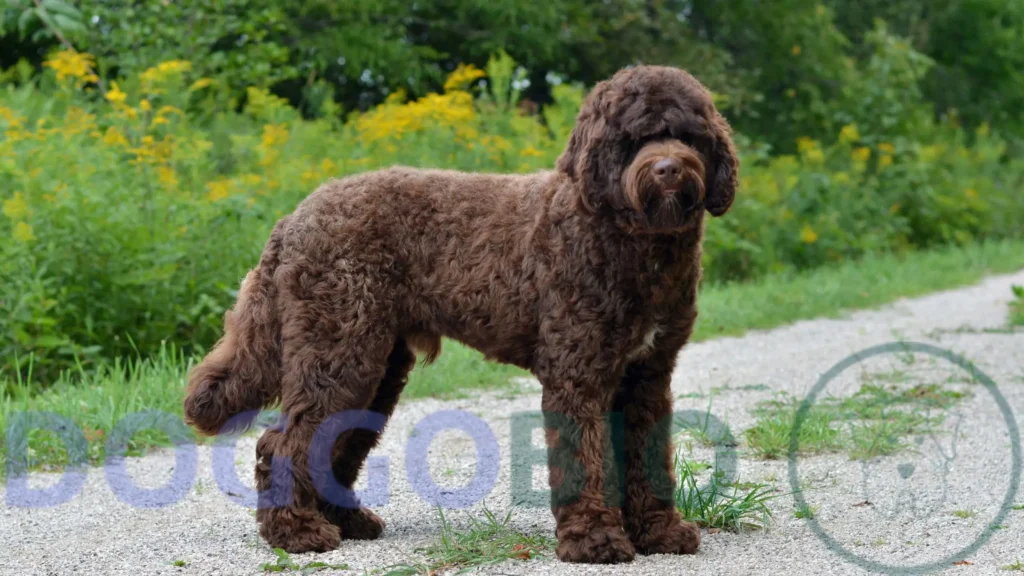
The Shaggy or Wavy Chocolate Coat combines the best straight and curly coats, resulting in a beautiful, low-maintenance option. This coat is slightly longer than the straight coat and features a gentle wave or loose curl, giving it a charming shaggy appearance, particularly around the ears and face.
It requires moderate grooming, regular brushing, and occasional trimming to prevent matting. Shaggy or Wavy Chocolate Goldendoodles are low-shedding but may benefit from professional grooming every 8-12 weeks.
Temperament and Personality
Chocolate Goldendoodles possess a friendly, playful, and affectionate temperament. Being a mix of Poodle and Golden Retriever, both breeds known for their excellent characters, they inherit these traits. They are knowledgeable, eager to please, and easy to train.
These social dogs thrive on human interaction, making them ideal family pets and great companions for children. Their calm, gentle nature and adaptability make them suitable for various living environments and excellent travel companions.
Training and Exercise Requirements
Ensuring regular exercise is crucial to keep your Chocolate Goldendoodle mentally and physically stimulated. Allocating at least 30 minutes daily for light activity or walks is recommended to maintain their overall well-being.
Regarding training, Chocolate Goldendoodles are known for their aptitude and intelligence, making them a favored choice among dog owners. Beginning training as soon as you bring your puppy home is ideal. They are responsive to positive reinforcement methods, so avoiding harsh or harmful training techniques is advisable.
Grooming and Cleaning
Maintaining the beautiful coat of a Chocolate Goldendoodle requires regular grooming to ensure its health and prevent mats and tangles. The specific grooming needs may vary based on their coat type, but they generally require regular brushing, bathing, and hair trimming.
- To prevent matting and tangling, brushing their coat at least once a week is recommended. Bathing them every 4-6 weeks helps keep their skin clean and fresh. Professional grooming every 6-12 weeks can be beneficial to maintain the desired shape and length of their coat.
- In addition to coat grooming, it’s essential to address other aspects of their hygiene. Regular nail trimming, teeth cleaning, and ear cleaning are necessary for their health and well-being.
You can keep your Chocolate Goldendoodle looking and feeling its best by providing proper grooming care.
Food and Diet
Providing a nutritionally balanced diet is essential for the health of your Chocolate Goldendoodle. Opt for high-quality dog food that contains all the necessary nutrients. It’s critical to steer clear of foods that contain artificial flavors, colors, and sugars.
Remember that certain ingredients that may be safe for humans can be toxic to Goldendoodles. Avoid feeding them grapes, alcohol, raisins, chocolate, garlic, or onion to ensure their well-being.
Life Expectancy and Common Health Issues
The lifespan of a Chocolate Goldendoodle typically ranges from 10 to 15 years, depending on various factors such as their overall health and the quality of care they receive. While they are generally healthy dogs, like any breed, they can be susceptible to specific health issues that require attention and care.
Some common health problems that Chocolate Goldendoodles may encounter include:
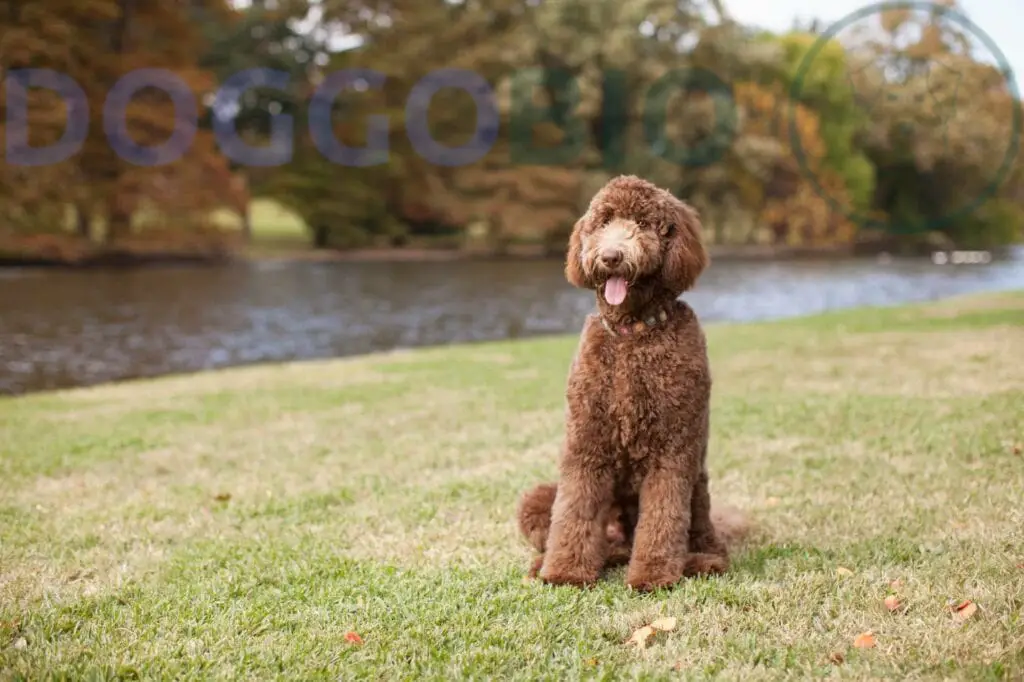
1. Hip Dysplasia
This condition is prevalent among many larger dog breeds, including the Golden Retriever and the Poodle. It involves improper hip joint development, leading to discomfort and stiffness.
2. Ear Infections
Chocolate Goldendoodles may be prone to ear infections with their long and floppy ears. Moisture and bacteria can get trapped, making regular cleaning and proper grooming essential in preventing such diseases.
3. Eye Problems
Certain eye conditions, including cataracts, glaucoma, or progressive retinal atrophy, may occur in Chocolate Goldendoodles. Regular check-ups with a veterinarian and appropriate eye care can help prevent and manage these conditions.
4. Skin Allergies
Chocolate Goldendoodles may have a predisposition to skin allergies, which can cause itching, scratching, and skin irritation. Proper grooming practices, a balanced diet, and regular veterinary care can aid in preventing and managing skin allergies effectively.
By ensuring regular exercise, a nutritious diet, and routine veterinary care, you can contribute to the overall well-being of your Chocolate Goldendoodle and potentially extend its lifespan. These delightful dogs can bring their fortunate owners years of love, companionship, and joy with proper care and attention.
How Much Do Chocolate Goldendoodles Cost?
As Goldendoodles continues to gain popularity worldwide, their prices have increased. The chocolate Goldendoodle, a rare color variation, tends to come with a slightly higher price tag than other color options.
Standard Goldendoodle colors such as Cream, gold, and apricot range from $1,000 to $2,000. However, rarer colors like chocolate, black, and grey can be priced between $1,500 and $3,000.
Is a Chocolate Goldendoodle the Right Dog for You?
Considering a Chocolate Goldendoodle as your furry companion requires thoughtful consideration of various factors. While these dogs are known for their friendliness, affection, and intelligence, they are also high-energy breeds that necessitate regular exercise and social interaction for their overall well-being.
Before committing to a Chocolate Goldendoodle, ask yourself the following questions:
- Can I devote time to exercise and grooming?
- Am I prepared to train and socialize an energetic dog?
- Can I provide a safe living environment?
- Can I afford their care and expenses?
- Does my lifestyle accommodate their needs?
A Chocolate Goldendoodle may fit you if your answers align positively with these questions. They are unique breeds that excel as family pets and loyal companions.
However, it’s crucial to work with a reputable breeder who can assist in finding the ideal dog and offer ongoing support throughout your companion’s life. A Chocolate Goldendoodle can bring years of love and companionship with proper care and attention.
Frequently Asked Questions
Do Chocolate Goldendoodles Shed A Lot?
No, Chocolate Goldendoodles are considered to be non-to-low shedders. While they may drop a few strands of hair here and there throughout the year, they do not shed much.
Cross-back generations like F1b, F1bb, or F2b shed even less than F1 Chocolate Goldendoodles.
Are Chocolate Goldendoodles hypoallergenic?
Yes, Chocolate Goldendoodles are considered hypoallergenic due to their low-shedding nature, which means they release less allergy-inducing dander into their environment.
F1b Chocolate Goldendoodles, which have a higher percentage of Poodle genes, are even more hypoallergenic than F1.
What makes Goldendoodle Chocolate Color?
The captivating chocolate color of the Goldendoodle is inherited from its parent breeds, the Poodle and the Golden Retriever. The Poodle contributes the chocolate gene, while the Golden Retriever adds a touch of dilution to the shade.
Although not rare in either breed individually, the chocolate Goldendoodle’s charm lies in its color, playful nature, affectionate demeanor, and remarkable intelligence.
Are Chocolate Goldendoodles Rare?
Yes, Chocolate Goldendoodles are considered relatively rare among the different coat colors of Goldendoodles. While they are not as common as Red, Apricot, or Cream Goldendoodles, they are not as rare as Sable or Merle Goldendoodles.
Their rarity is because the brown coat color can only be inherited from the Poodle side, so Chocolate Goldendoodles are typically found in second or third-generation litters where the genetics have been specifically bred for this color.
Conclusion
In conclusion, the Chocolate Goldendoodle represents the epitome of canine charm and companionship. With their stunning chocolate coats, lovable curls, and friendly nature, these dogs bring joy and warmth to any home.
Their intelligence and trainability make them versatile and adaptable to various lifestyles and activities. Moreover, their hypoallergenic qualities make them an ideal choice for individuals with allergies.
Whether you’re seeking a loyal family pet, an active outdoor buddy, or a therapy dog, the Chocolate Goldendoodle is the perfect blend of beauty, intelligence, and affection. Embrace the enchantment of this remarkable breed and experience the love and companionship that a Chocolate Goldendoodle brings into your life.

Pingback: Apricot Goldendoodles: Fantastic World of This Breed 2023
Pingback: Straight Hair Goldendoodle: Beauty Meets Love 2023
Pingback: Red Golden doodles: A Interesting Canine Companion 2023